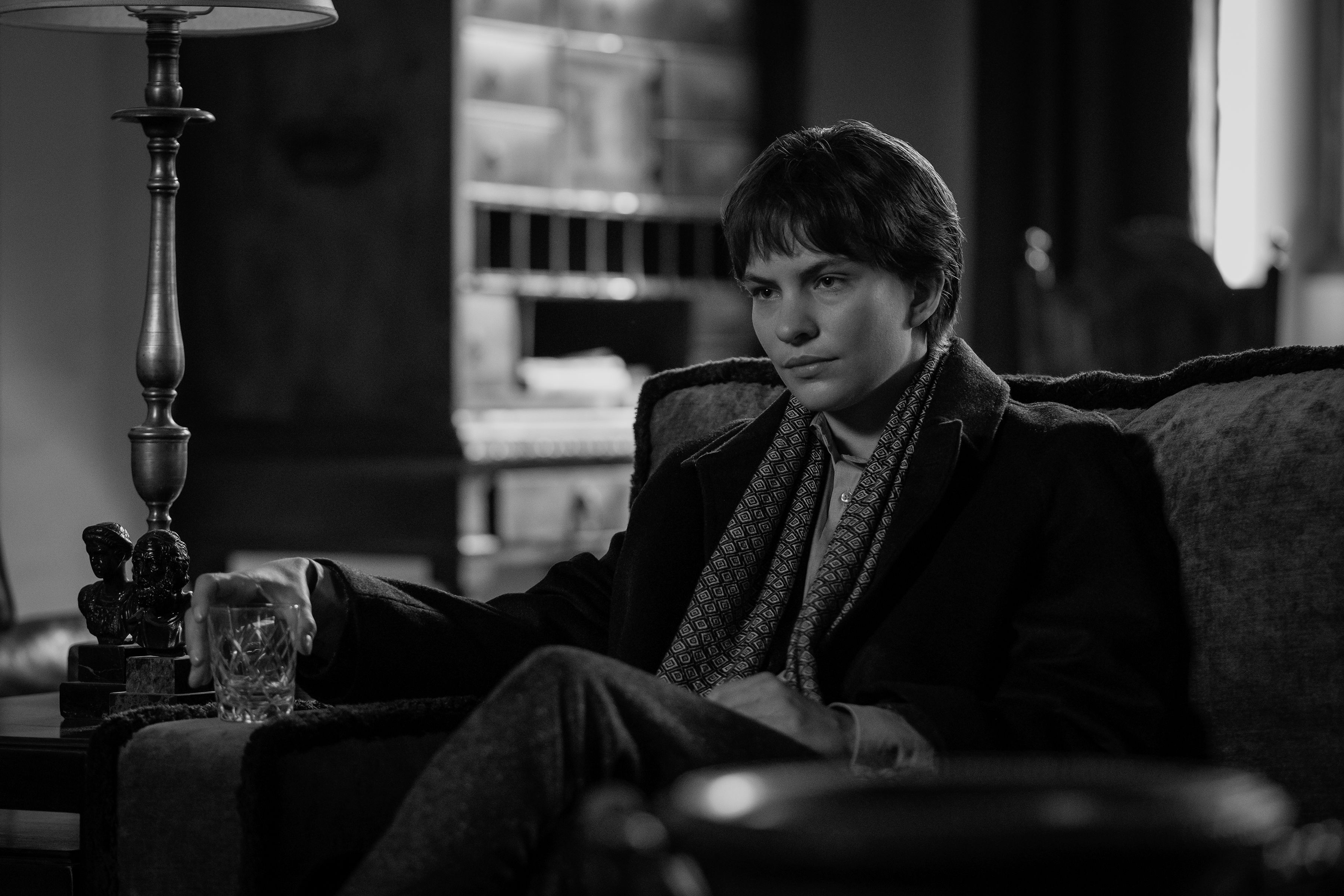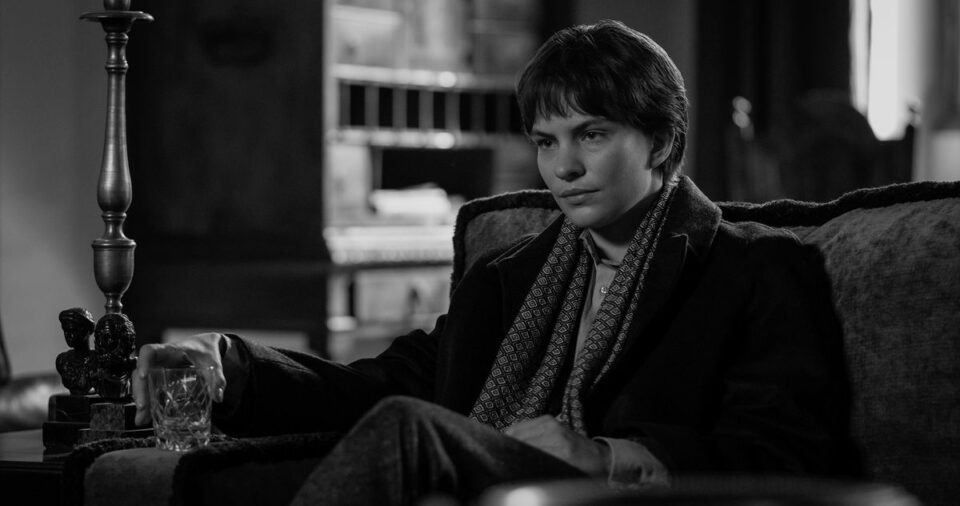
The sun has risen in Rome, and Tom Ripley is busy with errands. His to-do list is filled with the kind of responsibility particular to the unburdened. Every day in Dickie Greenleaf’s life is like a pleasantly productive Sunday when you do the shopping, go to the post office, bring a picture to get framed, and stop at a café to have an espresso in between tasks. Preparing to get settled into his new life, Tom visits an apartment. The landlady dislikes the English but doesn’t mind an American; she doubly doesn’t mind Dickie when she realizes that he is the heir to a ship-building business. The apartment is spacious, light-filled, and tastefully decorated, with beautiful views of the capital. A little bit of Tom Ripley emerges when the landlady opens the windows: His eyes dart around wildly, unbelieving, like a kid at Disney World. The apartment in Rome, for which he pays two months’ rent in advance, is in a way like Disney World: a place that, though it exists in reality, is assigned meaning by the imagination. It’s not merely an apartment in which Tom is hiding after committing a heinous murder; it’s Dickie Greenleaf’s apartment, one he would have perhaps chosen himself. Tom Ripley is in such a good mood that even the fact that the building’s elevator is broken can’t faze him — the stairs in Rome are nothing to someone who built major calf strength in Atrani.
When Tom comes home after going out to buy some records and a nice, heavy glass ashtray, he sees that the landlady has added the name “Greenleaf, R.” to the intercom directory. Tom rips it out before going upstairs and settling in front of Dickie’s typewriter to compose a letter to Marge. He tells her he loves the scarf and is wearing it as he writes; he also tells her that he is studying with a painter named Dimassimo and that because his only plan for the near future is to have no plan, he has given up on the idea of taking an apartment in Rome. The tone he assumes in the letter is almost unbearably patronizing: It’s ripe with the condescension that was Dickie’s natural register and, for that reason, is a brilliant document. In his ability to impersonate Dickie’s tone while also creating new fake information, he resembles another famous epistolary grifter: the author Lee Israel, who forged hundreds of letters assuming the identity of celebrities like Dorothy Parker and Katharine Hepburn (in Marielle Heller’s excellent film about her story, Can You Ever Forgive Me?, she is played by a pitch-perfect Melissa McCarthy). Israel’s grift emerged out of resentment for an industry that failed to recognize her work — she used her literary prowess for evil instead of good. But Tom’s ability to forge signatures and impersonate people was his work all along. Sitting in front of the typewriter and torturing Marge from a distance — it’s so much crueler to pretend that Dickie is thinking of her than to let him disappear into thin air — Tom is not just working, but channeling his purpose. Watching him bang away on the keyboard is like watching an artist at work.
In fact, most of “Lucio” revolves around the question of Tom’s cunning artistry: Let’s call this his “process” episode. After finishing the letter, he goes out to mail it and retrieve a suitcase containing Dickie’s painting materials from American Express, where a worker who had seen him as Tom Ripley eyes him suspiciously. Coming home armed with these new supplies, he does a little painting. Even though Tom has never shown any interest in developing his fine art skills, he is a better painter than Dickie ever was. In his life as Dickie, Tom is surrounded by and inspired to produce art: He paints, listens to music, writes letters. But the art form underlying all the others is more insidious. Tom is an actor — he is constantly performing Dickie. His decision to paint in the middle of the day, after a brief consideration of how Dickie might spend his hours, is a scene in the Dickie Greenleaf play of which he is director, audience, and star. Arguably, the thing that makes acting an art form, rather than just a series of mimetic gestures, is the actor’s interpretation. Andrew Scott’s Tom Ripley is different from Matt Damon’s or John Malkovich’s; he is more introspective and self-conscious, less volatile. Just as well, Tom’s Dickie Greenleaf is an interpretation. He is more affable and open than the real guy, like the way Dickie would’ve been if he never had even one negative thought. Tom as Dickie is Dickie if Dickie were nothing more than a concept, an idea.
That’s a pretty blissful way to live, like you exist only conceptually, immune to the real world’s interferences. It’s swimmingly for Tom until he hears the buzzer ring as he adds another layer of paint onto his canvas. Then, the telephone, and finally, a knock on the door. A British voice on the other side calls out Dickie’s name: Of all people, it’s Freddie Miles. Opening the door for him, Tom tells Freddie that Dickie is out running an errand and that he will be at a cafe afterward, but Freddie insists on waiting for him inside. Freddie is determined to push Tom’s buttons: He asks about Bob Delancey, about Tom’s shoes, and about his role in Dickie’s sudden evasive behavior. Freddie’s suspicion was raised at first by a Ripley-ean miscalculation: Dickie bailed on the Cortina trip without ever even sending Freddie a note. Besides, there’s the telephone: It’s listed under Dickie’s address and easily findable, even by an apparent doofus like Freddie Miles. Though heavy in implication, their conversation is stilted, colored by their mutual distrust. As Freddie, Eliot Sumner has impossibly large shoes to fill. In Minghella’s 1999 adaptation, he was played with supernatural panache by Phillip Seymour Hoffman, who knew better than anyone how to take a supporting role and create something unforgettable. But even if Sumner weren’t in the difficult position of being compared to Hoffman, their performance of Freddie wouldn’t have landed: It grates uncomfortably on the surface level, too self-aware to be convincing. Against Scott’s control, Sumner’s inability to relax into the character zaps the scene of tension, distracting from the mounting pressure that is supposed to push Tom over the edge.
Finally, Freddie eventually decides to leave and try to catch Dickie at the café. On his way out of the building, he has a maddening exchange with the landlady in which he insists that Dickie isn’t home while she insists he is. Freddie comes back upstairs. It’s not long after he opens the door that Tom strikes Dickie firmly in the head with the ashtray he had bought earlier. Unlike Dickie, Freddie doesn’t plead: He’s not alive for long enough.
Somehow both boring and stressful, the aftermath of the cold-blooded murder of a trust fund kid is part of Tom’s “process.” But if the immediate moments after Dickie’s death were filled with improvised presence as Tom moved relatively freely through the deserted open water, disposing of Freddie’s corpse is a much bigger problem. There are people everywhere; the landlady had seen him not only once but twice, and, Tom finds out as he attempts to bring Freddie’s corpse to his car, the elevator is broken again. Tom waits to act in the cover of night, and as he watches the clock tick, a plan starts to emerge. He pours more alcohol into Freddie’s system, burns some cigarettes, rehearses his story. After nightfall, and after stupidly dragging Freddie’s body down the stairs, Tom makes it out into the street, holding the corpse as if Freddie were merely drunk. When a lady walks by, he pushes Freddie against a wall and kisses him, an improvised gesture that truly only Tom Ripley could’ve come up with. He thinks he got away with it until, from behind him, a man asks if he can be of any help. “He’s had a lot to drink,” Tom laughs nervously. He finally manages to put Freddie in the car. He drives him out to a dim-lit, tree-lined street way past the Colosseum.
What follows is a clumsy back-and-forth that recalls the bit with the stairs that Zaillian established in the pilot. Every time Tom sits down, as he is about to sip his drink, he remembers something, and he has to get up again. Having arrived home after leaving Freddie’s body, he realizes — extremely late for an experienced murderer, if you ask me — that the less-than-brilliant plan of dragging Freddie down the stairs had left a trail of blood on the marble. As he cleans, he is watched by a cat who is adorable but definitely knows too much. Finally sitting down in the apartment he realizes he forgot to take Freddie’s passport and wallet from his jacket, which would have made the scene look less like a robbery and much more like a careless murder. On the way home, he drops Freddie’s passport in a gutter. Like when he had to sink the boat in which he had taken Dickie’s life, Tom drags his feet through it all, huffing and puffing like a teenager being forced to do a chore.
There are a few key differences between the murders of Dickie and Freddie, though they were both the result of the same tortured mind. The first felt more premeditated, like something Tom could see in the future, but he was trying to put it off for as long as possible until it finally caught up to him. Freddie’s death was an act of desperation: a consequence to the first crime, unplanned but still inevitable — quintessentially Ripley-esque in that it’s another few hundred yards down the slippery slope. The fear and melancholy that shrouded the aftermath of Dickie’s death aren’t there as Tom deals with the evidence from Freddie’s murder; now he is just disgusted and annoyed. In the novel, Highsmith emphasizes Tom’s frustration with his murder of Freddie. He didn’t want to kill another person, not because he regretted the first murder but because a second one jeopardizes the life he created in consequence of the first crime. Once again, in pursuit of a life of ease and uninterrupted pleasantness, Tom has created an interfering mess for himself. As “Lucio” draws to a close, Zaillian closes in on the blood still staining some of Tom’s building’s marble steps, now imprinted with the cat’s cute little paws.
Postscript
• Is anyone else wishing to have a good look at this mythical Bob Delancey? In the novel, he crashes Tom’s nice cabin, courtesy of the Greenleafs, on his voyage to Italy with a motley crew of other unsavory downtown characters. I’d love to see him at a party with Freddie, Dickie, Tom and Marge…
• As he is interrogating Tom on his life in New York and his relationship with Dickie, Freddie signs the painting that Tom had propped up on the easel “Picasso,” seemingly as a way to demonstrate that he can smell Tom’s bullshit. It made me LOL and also cringe so hard I literally closed my eyes and went aarghhh.
By Rafaela Bassili , 2024-04-04 23:19:02
Source link


